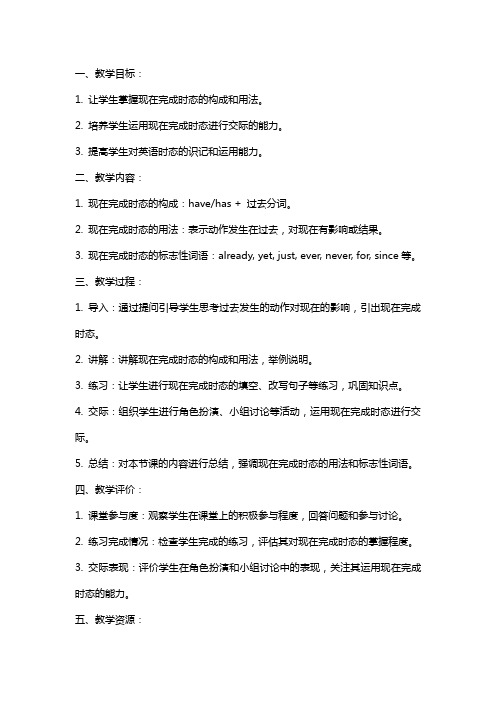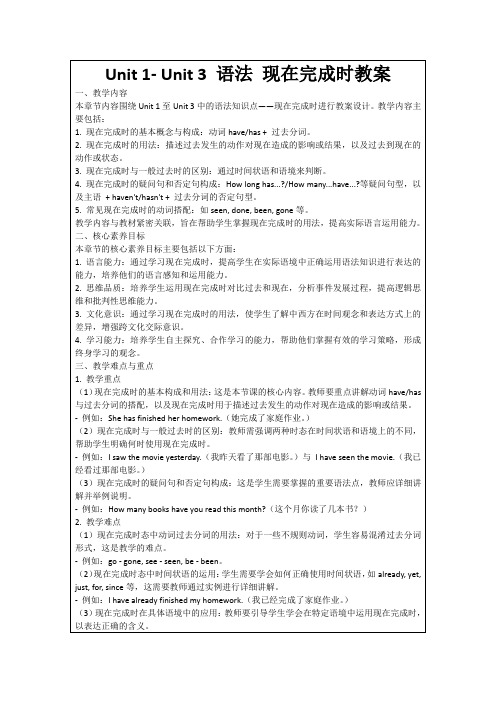现在完成时教案高中
现在完成时优秀教案

现在完成时优秀教案Classtype(课型):Revision(复习)课Topic(课题):ThePresentPerfectTense(现在完成时)Teachingobjectives(教学目标):知识与技能:1.HelpthestudentstograspthegrammarofthePresentPerfectT ense(复习、掌握语法现在完成时)2.提高学生的听、说、读、写、译的技能。
过程与方法:Trainthestudents’abilitiesofusingthePresentPerfectTense (培养学生熟练运用现在完成时的能力)运用“合作式”教学方法,“任务型”教学方法,“探究式”教学方法,“话题式”教学方法设置情景复习。
情感,态度和价值观:1.创设轻松、自然、快乐的英语学习氛围,增强主动学习意识。
2.建立英语学习的自信心和拥有语言学习的成就感。
教学重点:1.现在完成时与一般过去时的区别。
2.现在完成时的基本用法。
教学难点:瞬间动词与延续*动词的转化。
教学设计:先通过谈论一件刚发生过的事引入课题,然后通过练习——讨论——归纳,讲练结合引出现在完成时的一些基本用法,最后设计一组竞赛抢答题和情景会话,让学生在活动中学习,引导学生积极参与,主动实践,达到巩固掌握现在完成时的目的。
Teachingprocedure(教学步骤):StepILeadin(复习、导入)通过询问Whathaveyoudonesinceyougotupthismorning?引入课题现在完成时,同时也达到了warm-up的效果。
StepIIRevisetheformofthePresentPerfectTense(复习现在完成时的基本结构)1.先做练习,让学生自己发现、归纳现在完成时的基本结构。
2.让学生做口头练习,用现在完成时造句,复习、巩固现在完成时的基本结构。
此步骤目的在于由浅入深、循序渐进、提起学生的兴趣,同时达到训练学生的口语表达能力的目的。
现在完成时教学案

现在完成时教学案一、教学目标1. 理解现在完成时的概念和用法;2. 能正确地使用现在完成时的肯定句、否定句和疑问句;3. 能运用现在完成时描述自己的经历和经验。
二、教学重点1. 现在完成时的构成和用法;2. 肯定句、否定句和疑问句的结构;3. 运用现在完成时进行交流和描述。
三、教学内容1. 现在完成时的定义和形式a. 现在完成时表示过去发生的动作对现在的影响或结果;b. 构成:助动词“have/has” + 过去分词。
2. 现在完成时的肯定句a. 主语 + have/has + 过去分词;b. 例句:I have visited Beijing.3. 现在完成时的否定句a. 主语 + have/has + not + 过去分词;b. 例句:She hasn't finished her homework.4. 现在完成时的疑问句a. Have/Has + 主语 + 过去分词 + 其他?b. 例句:Have you ever been to Japan?5. 现在完成时的使用场景a. 表示过去经历或经验;b. 表示过去开始并持续到现在的动作;c. 表示发生在过去的动作对现在的结果。
四、教学过程1. 导入利用图片或实物创设一个与现在完成时相关的场景,引发学生对该时态的认知和兴趣。
2. 讲解与练习a. 通过示例句子和图表,讲解现在完成时的构成和用法;b. 让学生进行口头练习,使用现在完成时进行自我介绍。
3. 巩固与运用a. 分组活动:每个小组设计一个小对话,要求使用现在完成时进行交流;b. 学生展示对话,并进行全班讨论和纠错。
4. 拓展与延伸a. 学生分角色扮演,模拟一次面试对话,要求使用现在完成时描述个人经历和能力;b. 学生互相评价对方的表达是否准确和流利,提供建议和改进意见。
五、课堂小结在本节课中,我们学习了现在完成时的定义、构成和用法,通过不同的练习和活动,提高了学生运用该时态进行交流和描述的能力。
高中语法课课教案模板范文

一、课题名称高中英语语法课:《现在完成时》二、教学目标1. 知识与技能目标:- 学生能够掌握现在完成时的基本构成和用法。
- 学生能够正确运用现在完成时描述过去发生的动作对现在的影响或结果。
2. 过程与方法目标:- 通过小组合作探究,培养学生自主学习能力和合作学习能力。
- 通过情境创设,提高学生的实际运用英语的能力。
3. 情感态度与价值观目标:- 培养学生对英语学习的兴趣,增强学习信心。
- 培养学生尊重他人,团结协作的精神。
三、教学重点1. 现在完成时的构成:主语 + have/has + 过去分词2. 现在完成时的用法:描述过去发生的动作对现在的影响或结果。
四、教学难点1. 现在完成时与一般过去时的区别。
2. 现在完成时在语境中的运用。
五、教学过程1. 导入新课- 利用多媒体展示一些与现在完成时相关的图片或视频,激发学生的学习兴趣。
- 提问:同学们,你们知道现在完成时吗?它有什么特点呢?2. 语法讲解- 教师讲解现在完成时的构成和用法,结合例句进行讲解。
- 学生跟读例句,加深对现在完成时的理解。
3. 小组合作探究- 将学生分成若干小组,每组讨论以下问题:1)现在完成时与一般过去时的区别;2)现在完成时在语境中的运用。
- 各小组派代表分享讨论成果,教师点评。
4. 实践运用- 学生根据所学知识,完成以下练习:1)完成填空题,运用现在完成时;2)根据给定的句子,改写为现在完成时;3)根据情景,运用现在完成时进行对话。
5. 课堂小结- 教师总结本节课所学内容,强调现在完成时的构成和用法。
- 学生回顾本节课所学知识,巩固记忆。
六、作业布置1. 复习本节课所学内容,完成课后练习。
2. 预习下一节课内容,提前预习相关语法知识。
七、教学反思本节课通过多媒体导入、小组合作探究、实践运用等多种教学方法,帮助学生掌握现在完成时的构成和用法。
在教学过程中,要注意以下几点:1. 注重激发学生的学习兴趣,提高学生的学习积极性。
牛津上海版高二上英语第4讲现在完成时和现在完成进行时教案

1 对 3 指导讲义学员姓名:学科教师:年级:高二指导科目:英语讲课日期时间主题此刻达成时和此刻达成进行时1、理解“此刻达成时”及“此刻达成进行时”的定义、掌握基本时间状语及其用法;学习目标2、能够正确划分和灵巧运用这两种时态。
教课内容1、上一次课后稳固作业复习;2、互动探究教课建议:1、老师放音频让学生听写空白处单词或句子;2、可让学生哼唱或老师自己展现,以调换学生的学习兴趣;3、关于波及“此刻达成进行时”语法点的部分,老师可适合重复或增强,以惹起学生对时态的重视,而后引入本课解说内容。
You Make MeWe are one,One for sure ,All ______ (united) ,You’ ll want no more,Ohhhh you make me...Ohhhh you make me...We are ______ (one),One for sure ,All united ,You’ ll need no more,Ohhhh you make me....Ohhhh ....All my life, I’ ve been__________________ (I ’ ve been waiting for)someone like you - yeah !All my life, I’ ve beenI’ ve been waiting forsomeone like you - yeah !I ’ ve beenlooking for someone like you yeah !__________________ (I ’ ve been waiting for)someone like youYou make me...We are one.此刻达成时【知识梳理1】此刻达成时的一般用法1) 表示发生在过去的动作或存在的状态到说话时刚才达成或结束,往常使用不拥有连续意义的动词,arrive,become, begin, break 等。
现在完成时英语教案

现在完成时英语教案现在完成时英语教案【篇一:现在完成时-教学设计(全英文-超详细)】教学设计阳城四中赵育霞Ⅰ.teaching aims:1. knowledge:a. the structure of the present perfect tense.b. the usages of present perfect tense.2. ability:a. enable students to use the correct tense in their writing and speaking.b. enable students to use the right words in the present perfect tense.3. feelings and attitude:a. let the students know the importance of english grammar.b. try to buil d up students’ confidence in themselvesc. encourage students to speak english in public.Ⅱ. important points:let the students understands the usages of present perfect tense.Ⅲ. difficult points:help students use present perfect tense with verbs to describe events happen at a particular point in time and to describe events that can continue over a period of time.Ⅳ.teaching methodology:the new senior english curriculum standards aims education for all students and stressed quality-oriented education. the main task of education is to stimulate and cultivate students’ interest and their confidence in learning the language, help them developgood learning habits and form effective learning strategies, facilitate autonomy and cooperative spirit in learning ; enable students to master basic english language knowledge and skills in listening, speaking, reading and writing.according to the new standards, the students should be the center of the class and the teacher serves as a controller, organizer, participant, or resource-provider most times. considered with the characteristic of the teaching contents and the learners, i will apply explanation and practicing in my teaching. most of the usages will be summarized by students themselves.Ⅴ.teaching tool: pptⅥ. teaching steps:step1. revision lead-in (2min)1.invite students to read sentences using present perfecttense they have found before the class.s1: i’ve seen quite a lot of china.s2: i’ve visited some beautiful cities.s3: they have just completed it.s4: ...2. show some sentences on the board.1). they have put up a lot of high-rise buildings recently.2). my wife’s just bought a beautiful dress from one of the shops there.3). it’s got some really pretty parks.4). a friend’s told me about a nice f ish restaurant.step2. present perfect tense1. the structure of present perfect tense.after reading these sentences, ask students to find the structure of these sentences with present perfect tense.1). have/has+done2). have/has+not+done3). have/has+been+done2. the usage of present perfect tenseplay the flash (a pig and his mom), and tell students to recall the main usages of this tense.q: the story happens in the past, but the pig and his mom use present perfect tense to describe it, can you tell me the reason? draw a time line on the blackboard:1). usage1: “完成用法”①强调过去发生的动作对现在造成的影响或结果,常用状语有:already, yet, never, ever, just, before ...e.g.1. i have just cleaned my hands.e.g.2. i have lost my wallet.e.g.3. i have already finished my homework. i am free.②show the following sentences and have students summarize the difference between the past simple tense and present perfect tense.he has already read that book. (说明他现在知道那本书的内容) he read that book last year. (只说明他去年读过那本书 )he has gone to america. (他现在不在此地, 在美国)he went to america eight weeks ago. (只说明他去过美国)summary:一般过去时表示过去发生的动作或存在的状态,与现在情况无关,常用时间状语为yesterday, last year, in the past等,而现在完成时与现在有关。
现在完成时态(复习课教案)

一、教学目标:1. 让学生掌握现在完成时态的构成和用法。
2. 培养学生运用现在完成时态进行交际的能力。
3. 提高学生对英语时态的识记和运用能力。
二、教学内容:1. 现在完成时态的构成:have/has + 过去分词。
2. 现在完成时态的用法:表示动作发生在过去,对现在有影响或结果。
3. 现在完成时态的标志性词语:already, yet, just, ever, never, for, since等。
三、教学过程:1. 导入:通过提问引导学生思考过去发生的动作对现在的影响,引出现在完成时态。
2. 讲解:讲解现在完成时态的构成和用法,举例说明。
3. 练习:让学生进行现在完成时态的填空、改写句子等练习,巩固知识点。
4. 交际:组织学生进行角色扮演、小组讨论等活动,运用现在完成时态进行交际。
5. 总结:对本节课的内容进行总结,强调现在完成时态的用法和标志性词语。
四、教学评价:1. 课堂参与度:观察学生在课堂上的积极参与程度,回答问题和参与讨论。
2. 练习完成情况:检查学生完成的练习,评估其对现在完成时态的掌握程度。
3. 交际表现:评价学生在角色扮演和小组讨论中的表现,关注其运用现在完成时态的能力。
五、教学资源:1. PPT课件:展示现在完成时态的构成、用法和标志性词语。
2. 练习题:提供现在完成时态的填空、改写句子等练习。
3. 角色扮演道具:用于学生进行角色扮演活动。
4. 小组讨论话题:提供相关话题,引导学生进行小组讨论。
六、教学步骤:1. 复习导入:通过提问学生关于他们已经学过的现在完成时态的知识,复习之前的学习内容。
2. 实例分析:通过展示一些具体的例子,让学生进一步理解现在完成时态的用法和构成。
3. 练习巩固:设计一些练习题,让学生进行现在完成时态的填空、改写句子等,以巩固他们的知识。
4. 小组活动:将学生分成小组,让他们通过讨论和交流,共同完成一些有关现在完成时态的任务。
5. 课堂总结:对这节课的内容进行总结,强调现在完成时态的重要性和使用场景。
Unit1-Unit3语法现在完成时教案

5.加强与学生的互动,及时了解他们的学习需求和困惑,以便调整教学策略,使课堂更加生动有趣。
3.成果分享:每个小组将选择一名代表来分享他们的讨论成果。这些成果将被记录在黑板上或投影仪上,以便全班都能看到。
(五)总结回顾(用时5分钟)
今天的学习,我们了解了现在完成时的基本概念、重要性和应用。同时,我们也通过实践活动和小组讨论加深了对现在完成时的理解。我希望大家能够掌握这些知识点,并在日常生活中灵活运用。最后,如果有任何疑问或不明白的地方,请随时向我提问。
3.现在完成时与一般过去时的区别:通过时间状语和语境来判断。
4.现在完成时的疑问句和否定句构成:How long has...?/How many...have...?等疑问句型,以及主语+ haven't/hasn't +过去分词的否定句型。
5.常见现在完成时的动词搭配:如seen, done, been, gone等。
(3)现在完成时的疑问句和否定句构成:这是学生需要掌握的重要语法点,教师应详细讲解并举例说明。
-例如:How many books have you read this month?(这个月你读了几本书?)
2.教学难点
(1)现在完成时态中动词过去分词的用法:对于一些不规则动词,学生容易混淆过去分词形式,这是教学的难点。
(3)现在完成时在具体语境中的应用:教师要引导学生学会在特定语境中运用现在完成时,以表达正确的含义。
-例如:在描述经历、询问别人经历或谈论过去发生但对现在有影响的事情时使用现在完成时。
(4)现在完成时与一般过去时的区分:这是学生容易混淆的地方,教师需要通过丰富的例句和情景练习来帮助学生突破这一难点。
Unit3DiscoveringUsefulStructures现在完成时教学设计-高中英语外研版

Teaching planThe Present Perfect Tense(现在完成时)2024届英语备课组I.Teaching Aims:1.Knowledge aimHelp students know, and master the forms, usages, markers and sentence patterns of the present perfect tense.2.Ability aimGuide students to use the present perfect tense to describe the people or things in their daily life freely and at the same time improve their writing abilities.3.Emotion aimCultivate students’ team spirit and their interesting in English.II. Teaching key pointsHelp students to know and master the forms, usages, markers and sentence patterns of the present perfect tense.III. Teaching difficult pointsGuide students to use the present perfect tense to describe their daily life.IV. Student analysis:The students have learned the grammar during their junior high but the students belong to the second level in our school, so their knowledge foundation about this grammar is weak. But they are full of energy and passion for the lesson.V. Teaching procedures:Grammar is a boring part for students, so the teacher doesn’t just analyze the grammar rules only, but ask students to learn and summarize by themselves, also, the teacher ask students to watch a short video, play a game, recite sentences and cooperate with partners to kill the boredom.。
- 1、下载文档前请自行甄别文档内容的完整性,平台不提供额外的编辑、内容补充、找答案等附加服务。
- 2、"仅部分预览"的文档,不可在线预览部分如存在完整性等问题,可反馈申请退款(可完整预览的文档不适用该条件!)。
- 3、如文档侵犯您的权益,请联系客服反馈,我们会尽快为您处理(人工客服工作时间:9:00-18:30)。
现在完成时教案高中【篇一:现在完成时教案】现在完成时教案teaching aims: 现在完成时用法teaching points 1. 现在完成时的构成现在完成时是由助动词 have(has)+动词的过去分词构成。
助动词说明该谓语是属于现在时范围。
它和主语的人称、数要保持一致。
过去分词是主要的谓语动词,说明句子的意义。
teaching steps:1. 现在完成时的用法(1)表示动作发生在过去某个不确定的时间,但对现在留下了某种影响和结果。
常被just、already、yet 等副词修饰。
如: -have you had lunch yet?-yes, i have. ive just had it.你(已经)吃午饭了吗?我刚刚吃过。
(现在我不饿了)(2)表示从过去某一时刻开始一直持续到现在的动作或状态。
这个动作可能刚停止,可能仍然在进行。
常带有for和since等表示一段时间的状语。
如:he has taught here since 1981他自1981年就在这儿教书。
(可能还要继续教)i havet seen her for four years.我有四年没见到她了。
(3)表示说话前发生过一次或多次的动作,现在成为一种经验,一般译为汉语“过”,常带有twice,ever,never,three times等时间状语。
如: i have been to beijing twice.我去过北京二次。
3.现在完成时的时间状语(1)现在完成时属于现在时范围,故不能和过去的时间状语连用。
如:yesterday,last sunday,in1990,three years ago等。
但是,在强调动作产生的后果和影响时,可以和一些表示不确定的时间状语连用。
a. 用副词already和yet。
already一般用于肯定句中,yet一般用于否定句和疑问句中。
如:we have already finished our homework.我们已完成作业了。
they havent finished their homework yet.他们还没有完成作业。
b.用ever 和never。
多用于否定或疑问句中,表示“曾经”或“从未“等。
如: -have you ever been to the great wall?你曾经去过长城吗? -i have never been to the great wall.我从未去过长城。
c.用表示到说话为止的过去时间状语,如just, before, up to now, the past few years 等。
例如:i have seen her before, but i can not remember where.我以前见过她,但记不起在哪里见过。
he has been there three times the last few days.近几年他去过那里三次了。
d.用包括“现在”在内的时间状语,如:now, today, thismorning(month, year, term)等。
例如:-have you met him today?-no, i havent.今天你见过他吗?我没有。
how many times have you been there this year?今年你去过那里多少次?(2)现在完成时可以和带有since或for等表示“一段时间”的状语连用,表示动作或状态从某一时刻开始,一直持续到现在。
如:i havent seen him for two years. 但是,像come, arrive, buy等终止性动词不能与表示“一段时间”的状语连用。
要用,必须改为“be (在)”等延续性动词来表述。
exercise:i. fill in the blanks with the proper form.1. i____ already ____ (see) the film. i ________ (see) it last week.2. _____ he ____ (finish) his work today? not yet.3. my father ____ just ____ (come) back from work. he is tired now.4. where’s li ming ? he __________ (go) to the teacher’s office.5. i __________ (work) here since i ______ (move) here in 1999.6. so far i _______________(make) quite a few friends here.7. how long ________ the wangs ______________(stay) here ? for two weeks.8. i ________ just ___________ (finish) my homework.9. he ________ (go) to school on foot every day.10.____ you ______ (find) your science book yet?黑板设计【篇二:现在完成时教案】教学过程一、复习预习1.引入:i have read this book twice. read 动作发生在过去。
2.现在完成时的动作发生在过去,对现在造成的影响。
3.现在完成时结构中have/has的作用:通过do/dose/be等联想法推导出have/has的语法功能。
二、知识讲解本节课主要知识点解析,中高考考点、易错点分析考点/易错点1基本结构:助动词have/has+过去分词(done)否定句:主语+have/has+not+过去分词+其他.一般疑问句:have/has+主语+过去分词+其他.简略答语: yes, 主语 + have/has.(肯定) no, 主语 +havent/hasnt.(否定) 用法(1)现在完成时表示过去发生或已经完成的动作对现在造成的影响或结果i have spent all of my money (so far).(含义是:现在我没有钱花了.) guo zijun has (just/already) come. (含义是:郭子君现在在这儿) my father has gone to work.(含义是:我爸爸现在不在这儿)(2)现在完成时可以用来表示发生在过去某一时刻的,持续到现在的动作(用行为动词表示)或状态(be动词表示),常与for(+时间段)或since(+时间点或过去时的句子)连用.①for+时段②since+过去一个时间点(译为:自从??以来)③since+时段+ago④since+从句(过去时)⑤it is+时段+since+从句(过去时) mary has been ill for three days.i have lived here since 1998.考点/易错点2现在完成时和一般过去式的区别:一般过去时和现在完成时所表示的动作都发生在过去,那么这两种时态有什么区别呢?①一般过去时常与具体的表示过去的时间状语如yesterday, last year, just now等连用;强调动作在过去发生,与现在无关。
②现在完成时与自已的特征词already ,yet ,just ,ever ,never,before等连用,强调过去发生的动作对现在的影响或过去开始发生一直持续到现在的动作。
例: he saw the film last night. (过去时,表示他昨晚看过那部电影了,现在不知还要不要再看一次)he has (ever) seen the film before.(现在完成时,表示他已看过那部电影,现在不想再看了)③现在完成时可表示持续到现在的动作或状态,动词一般是延续性的。
如:live, work,study等。
而一般现在时对动词是否延续无任何要求。
时间状语的区别:除了我们讲过的already, yet, still,just, ever, never, since短语和 for短语外,还有许多时间状语常用于现在完成时,我们要留心将它们和一般过去时的时间状语区分开来:1. lately, recently是完成时的时间状语;just now 有a moment ago 之意,是过去时的时间状语。
如:have you heard from your family lately/recently? did you see joan just now?2. in the past few years 意思是“过去几年来”,常用于完成时中;in the past意思是“在过去”,常用于过去时中。
如:great changes have taken place in my hometown in the past few years.where did you work in the past?3. ever since then与from then on / after that 都有“打那以后”之意,但前者常用于完成时,而后两者常用于过去时。
如:shes lived here ever since then. i didnt hear of jim from then on/after that.4. before 通常用于完成时;...ago通常用于过去时。
如:i have never been to japan before.she went to japan two years ago.5. so far“到目前为止”,these days“这些天来”也是现在完成时常见的时间状语。
如: so far, no man has travelled farther than the moon.what have you done these days?考点/易错点3:现在完成时动词持续性用法持续性用法(肯定句,疑问句中谓语动词必须是延续性动词):表示过去已经开始,持续到现在的动作或状态。
此时常与“for +一段时间或“since+过去的点时间或从句(从句用一般过去时)以及so far(到目前为止)等时间状语连用。
for + 段时间/ since +点时间例:1)ive lived here since 1990.自从1990年以来我就住在这里。
= ive lived here since 21 years ago.= ive lived here for 21 years.= it is 21 years since i began to live here.注意:①在这类句子的肯定句和疑问句中谓语动词必须用延续性动词。
